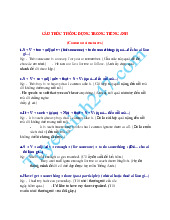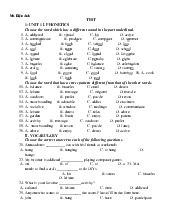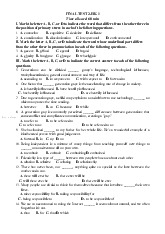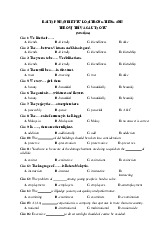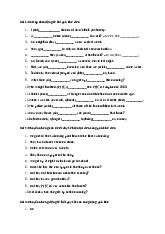Preview text:
lOMoAR cPSD| 48641284 UNIT 7 1.
How many of small fibers that make up each muscle are there?
Although there are different types of muscles in the body, all of them are made of
the same material called fibers. There are thousands or even tens of thousands of
these small fibers that make up each muscle 2.
Which muscle show how strong someone may be?
Skeletal muscles are the voluntary muscles, which mean you can control what they
do. They are the muscles that show how strong someone maybe and let them physically exert the body 3.
Where are the biggest and most powerful muscles?
The skeletal muscles in the back and near the spine are the biggest and most powerful
muscles. They help keep a person upright and standing tall. 4.
What are all muscles made of?
Although there are different types of muscles in the body, all muscles are made of
the same material, a type of elastic tissue resembling a rubber band which is also known as fibers. 5.
Which bones protect the heart, lung and stomach in case of injury? Ribs are
bones that protect the heart, lungs or stomach in case of injury. Together with the sternum, they
make the bony rib cage which covers the chest 6.
What's the biggest and strongest joint in the body?
About joints, they are where two bones come together and the biggest and strongest
joint in the body is the knee joint 7.
How many regions are there in the spinal column? What are they? The 26
vertebrae of the spinal column are divided into 5 regions: cervical (7) → thoracic (12) → lumbar
(5) → the sacrum (5 fused) → the coccyx ( 4-5 fused).
Between the vertebrae are disks of cartilage that add strength and flexibility to the spine lOMoAR cPSD| 48641284 8.
What are the function of smooth muscle?
In the stomach and digestive system, smooth muscles contract and relax to allow
food to make it journey through the body.
In the bladder, it relax to allow a person to hold in urine or contract to push urine out 9.
How does the cardiac muscle work?
The muscles in the heart are called cardiac muscles. When they(cardiac muscles)
contract, they pump blood out and relax to get blood back after it has circulated through the body. 10.
How do the skeletal muscle work?
Skeletal muscles are the muscles that you can control. They cover the bones to
provide strength and flexibility to the body. By connecting to tendons, when a muscle
is contracted, the tendon and bone move along with it. This leads to the movement of our body. Unit 6 11.
What are the component parts of the urinary system ?
The urinary system consist of : two kidney, two ureter, the urinary bladder and a urethra. 12.
How many ureters are there?
There are two ureters, one attached to each kidney 13.
What is the Bowman’s capsule?
The Bowman’s capsule is a cup – shaped structure surrounding the glomerulus. It
collects the liquid waste that is filtered out of the blood. 14.
What is Erythropoietin?
EPO is a hormone that stimulates the production of red blood cells in the bone marrow lOMoAR cPSD| 48641284 15.
How many layers do the kidneys consist of? What are they?
I think kidneys consist of 3 layers. They are: capsule, cortex and medulla = nang/ vỏ/ tủy 16.
What's the main function of the glomerulus? It filter the blood. 17.
What's the main function of the kidneys?
The main function of the kidneys is to removing liquid waste from the blood in the form of urine.
The function of the kidneys are to removing liquid waste from the blood in the form
of urine, keep a stable balance of salts and other subtances in the blood and produce EPO. 18.
What is the functions of the urinary system?
It filters the blood and create urine as a waste by- product
This system forms and eliminates urine, which contains metabolic waste products 19.
What's the function of the sphincter muscle?
The function of the sphincter muscle is to help keep urine from leaking Unit 5 20.
Where does the digestive system begin?
The digestive system begins at the mouth and ends at the anus 21.
What does the liver secrete?
Bile is yellowish, blue and green fluid secreted from the liver. It is sometimes called gall
and is stored in the gallbladder between meals. 22.
What is absorbed in the small intestine and the large intestine? It absorbs
nutrients from the food such as protein, vitamin, … It absorbs water from undigested food. 23.
What happens when the food goes into the small intestine? lOMoAR cPSD| 48641284
The small intestÝne have a lot of villi which help them absorb nutrients from the food such as protein, vitamin, … 24.
How many parts does the small intestine have?
The small intestine have three parts. They are duodenum, jejunum, ileum.
It consist of are three parts. The first part is duodenum, the middle part is jejunum, the last part is ileum. 25.
How many parts does the large intestine have?
The large intestine have four parts. They are cecum, colon, rectum, anal canal 26.
How many main steps does the digestive system consist of?
The digestive system is designed to do a few major things. They can be grouped into four
categories: ingestion, digestion, breakdown, excretion 27.
What are the functions of the pancreas?
The function of the pancreas is help the body produces enzymes that are released to the small intestine. 28.
What are the function of the digestive system?
In my opinion, it breaks nutrients into parts small enough for your body absorbs and use
for energy, growth and cell repair.
Talk about what you know about one part assigned by the examiner Organ
Position & function Mouth
Mouth is the first part of this system. The food
enters our mouth then be chewed and broken
down by our teeth. It also helps in speaking Esophagus
it is a part of the digestive system. It is very
important. It is a tube that connects the
pharynx to the stomach so this organ helps the
body channels the food from the pharynx into the stomach. Stomach
it is a part of the digestive system. It is very
important. It is J-shaped in the abdomen. This lOMoAR cPSD| 48641284
organ produces acid and enzymes to digest food. Small intestine
It has 3 parts:duodenum, jejunum, ileum.
Digestion finishes here, all the nutrients are
absorbed from the small intestine and move
into the blood stream via a system of small folds, call vili Large intestine
In the abdomen. Is shorter than small intestine
Has different region which are cecum,
ascending colon, transverse colon, descending
colon, sigmoid colon, rectum and anal canal
Its function is to absorb water from undigested food Ileum
The last region of small intestine helps to
further digest food coming from the stomach
and other parts of the small intestine Rectum
It’s the lower part of the LI. Rectum stores the
feces. It helps to remove waste out of the body Anus
located at the end of digestive system
it function is to eliminate the feces from the body Liver
it is a part of the digestive system. It is very important
In the upper right-hand part of the abdominal cavity The function of this organ is that produces bile Gall bladder
it is a part of the digestive system. It is very
important. This organ stores bile from live Pancreas
It is in the abdomen,and help the body
produces enzyme that are released to the small intestine Appendix
Is the beginning of large intestine. It is small
tube attached to the cecum and has no function Salivary gland
Produces saliva and keep the mouth wet, prepare food to digested Organ
Position & function lOMoAR cPSD| 48641284 Kidneys
-They are located below the ribs toward the middle of the back
- They are purplish-brown organs.
- Their function is to removing liquid waste
from the blood in the form of urine, keep a
stable balance of salts and other subtances in the blood and produce EPO. Ureters
-There are two ureters, one attached to each kidney
- They are narrow tubes that carry urine from the kidneys to the bladder Bladder
-It’s a triangle-shaped and hollow organ. It is located in the lower abdomen
- it’s funcion is to temporarily store urine Spincher - There are two sphincters
-They are circular muscle that help keep urine
from leaking by closing tightly like a rubber
band around the opeing of baldder Urethra
-The urethra is a passageway located in your body’s pelvic region
-It is a tube that allows urine to pass outside the body Cortex
Is outer region of the kidney.
It contains nephrons, which are the functional
units responsible for filtering blood and forming urine Renal capsule
Fibrous covering around each kidney.
Provides support and protection for the kidney Renal pelvis
Funnel-shaped structure in the inner part of the kidney.
Collects urine from the nephrons and funnels it into the ureter. Calyx
Cup-like structures within the kidney.
Collect urine from the renal pelvis and transport it to the ureter Medulla Inner region of the kidney.
Contains structures like renal pyramids and is
involved in the concentration of urine Organ
Position & function lOMoAR cPSD| 48641284 Skull
- Consists of 8 cranial bones and 14 bones of the face
- Protects the brain and provides structure for the face Tendon - Connects muscle to bone.
-Transmits the force generated by muscle
contraction to the bone, allowing movement Joint -
The place where two bones come together is called a joint -
Facilitates movement and provides flexibility Smooth muscle
-Found in the walls of internal organs, blood
vessels, and other structures.
-Involuntary muscle contraction that
contributes to the movement of internal
organs, such as those in the digestive and circulatory systems. Skeletal muscle
- Attached to bones by tendons
- Skeletal muscles are the voluntary muscles,
which mean you can control what they do.
They are the muscles that show how strong
someone maybe and let them physically exert the body Cadiac muscle
- Makes up the heart and only covers walls of the heart.
-When they contract, they pump blood out and
relax to get blood back after it has circulated through the body. Ligament
- You have ligaments around your knees,
ankles, elbows, shoulders, and other joints -
They connect bone to bone, give your joints
support, and limit their movement Sternum
- Located in the center of the chest.
- Protects vital organs in the chest and serves
as an attachment point for ribs and muscles Rib cage
- Surrounds the thoracic cavity.
-Protects the organs in the thoracic cavity, such
as the heart and lungs, and assists in the process of breathing
